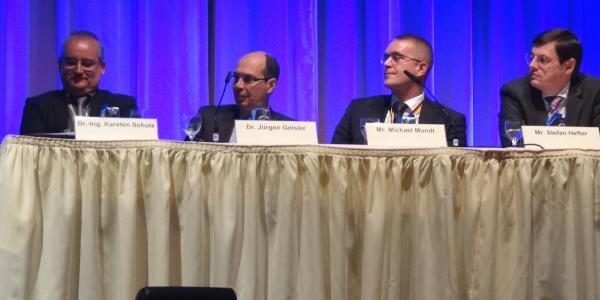AFCEA Hosts European Geoinformation Symposium and Exposition
Urbanization, migration and disaster relief are topics that are ubiquitous in the 21st-century news media. Frequently, critical or crisis-related aspects are in the foreground. These include megacities out of control, migration flows triggered by economic and violent conflicts, and inadequate or delayed disaster relief.
However, most crises in the context of conurbations, migration and environmental disasters are not short-term developments, but evolve over the long or medium term. Governments and nongovernmental organizations must deal with these phenomena promptly and permanently, address them publicly and face up to the challenges resulting from them.
These topics were at the core of TechNet Europe 2015, AFCEA Europe’s leading event, held October 20-22 in Berlin at the Maritim Hotel. The conference theme was “Urbanization, Migration, Disaster Relief: Key Challenges of the Future.” Hosted jointly by AFCEA Europe, the Bundeswehr Geoinformation Center (BGIC) and the AFCEA Bonn Chapter, TechNet Europe also provided the first European Geoinformation Symposium and Exhibition in cooperation with the Bundeswehr Geoinformation Service. The symposium was organized under the auspices of the German Ministry of Defense, Berlin.
AFCEA’s European office runs several large events each year featuring international venues that encourage chapter participation and attract an audience from across Europe and the United States. The TechNet series of events ensures regular contact with NATO by inviting civilian and military speakers from the NATO Headquarters staff, strategic commanders’ staffs and supporting agencies to attend.
TechNet Europe highlighted that the study of megacities, migration and disaster relief shows that these topics are multifaceted, complex and largely interdependent. Consequently, the approach to tackle the challenges they present must be interdisciplinary rather than intradisciplinary, according to conference speakers. Comprehensive interaction and, above all, international cooperation, are additional factors in addressing crises.
Even though the characteristics, dimensions and manifestations of these developments hardly are foreseeable in detail, it is essential to respond to particularly threatening changes by performing cause-and-effect analyses and taking preventive measures and actions, speakers said. This also means being prepared to respond quickly to potentially hazardous situations and damaging events.
The first European Geoinformation Symposium focused on environmental, geopolitical and security-related developments as well as selected aspects of human geography—the study of the interaction between people and their environment—and specific requirements for sensor technologies and data fusion. It provided a 2 1/2-day forum for a constructive dialogue among well-versed and competent representatives from industry, research, government and the armed forces.
More than 20 international exhibitors presenting the leading edge of modern communication and information applications accompanied the conference. In addition to the exhibition, six joint panel discussions took place with top leaders in the military, science and research, specialized institutes and industry. Sessions and panels focused on geo-factor’s risk potential—methodologies, prevention and response; technology challenges and opportunities; security policy effects; and human geography data analysis and management.
Subject matter experts from Bundeswehr, NATO, the EU, the U.N. and other groups ran the panels, which attracted high-ranking international participants. The panels also offered extensive opportunities for attendees to talk to the subject matter experts.





Comments